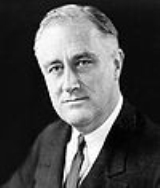
United States presidential election, 1932
Overview
Wall Street Crash of 1929
The Wall Street Crash of 1929 , also known as the Great Crash, and the Stock Market Crash of 1929, was the most devastating stock market crash in the history of the United States, taking into consideration the full extent and duration of its fallout...
, the Smoot-Hawley Tariff Act of 1930, the Revenue Act of 1932
Revenue Act of 1932
The Revenue Act of 1932 raised United States tax rates across the board, with the rate on top incomes rising from 25 percent to 63 percent...
, and the Great Depression
Great Depression
The Great Depression was a severe worldwide economic depression in the decade preceding World War II. The timing of the Great Depression varied across nations, but in most countries it started in about 1929 and lasted until the late 1930s or early 1940s...
were being felt intensely across the country. President Herbert Hoover
Herbert Hoover
Herbert Clark Hoover was the 31st President of the United States . Hoover was originally a professional mining engineer and author. As the United States Secretary of Commerce in the 1920s under Presidents Warren Harding and Calvin Coolidge, he promoted partnerships between government and business...
's popularity was falling as voters felt he was worsening the depression through his excessive spending and protectionism. Franklin D. Roosevelt
Franklin D. Roosevelt
Franklin Delano Roosevelt , also known by his initials, FDR, was the 32nd President of the United States and a central figure in world events during the mid-20th century, leading the United States during a time of worldwide economic crisis and world war...
criticized Hoover's excessive spending and his protectionist policies; in fact, his running mate John Nance Garner
John Nance Garner
John Nance Garner, IV , was the 32nd Vice President of the United States and the 44th Speaker of the United States House of Representatives .- Early life and family :...
accused Hoover of "leading the country down the path of socialism." Roosevelt won by a landslide, and this "critical election" marked the collapse of the Fourth Party System
Fourth Party System
The Fourth Party System is the term used in political science and history for the period in American political history from about 1896 to 1932 that was dominated by the Republican party, excepting the 1912 split in which Democrats held the White House for eight years. History texts usually call it...
or Progressive Era
Progressive Era
The Progressive Era in the United States was a period of social activism and political reform that flourished from the 1890s to the 1920s. One main goal of the Progressive movement was purification of government, as Progressives tried to eliminate corruption by exposing and undercutting political...
.
Unanswered Questions

